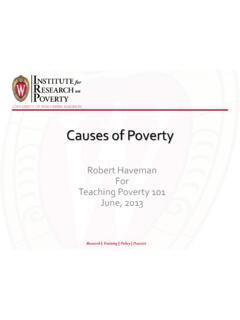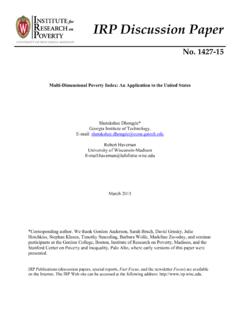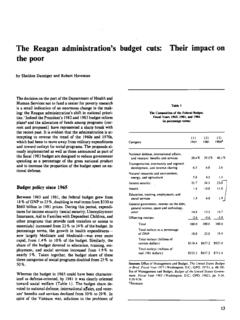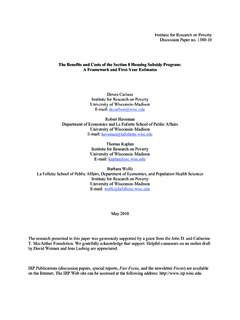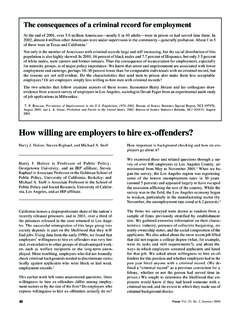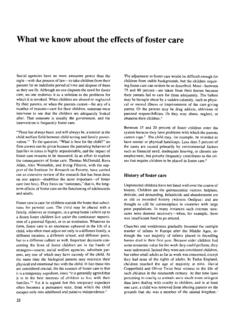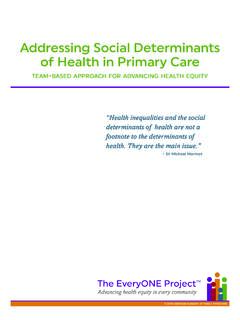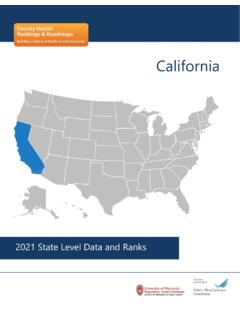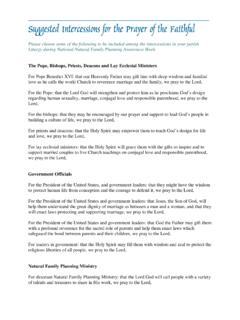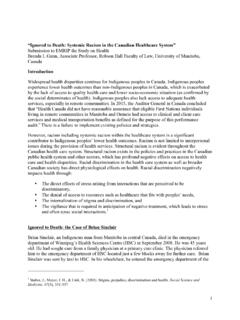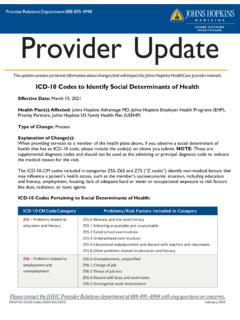Transcription of Health care for the poor: For whom, what care, and whose ...
1 69 Health care for the poor: For whom, what care, and whose responsibility?with low income, such as low education, the inability to speak English, and residence in areas with high levels of pollution, also contribute to poor Equally important, the link between poverty and poor Health does not go in just one direc-tion. Poor Health is a contributing factor to low incomes and poverty . People with chronic medical conditions frequently are poor because they cannot work, and people who suffer a sudden decline in Health often become poor after losing their job.
2 Moreover, people with chronic illness often have difficulty accessing medical care because they are not good advocates for themselves and too few medical providers are nearby, and they then remain poor because they cannot fact that people in poor Health often have low incomes as a result of their Health problems is an increasingly important driver of efforts to expand eligibility for public insurance. This is especially the case in efforts to increase coverage of chil-dren. As we have come to appreciate how poor Health can af-fect learning, which in turn is related to a person s productivity and earnings, awareness has grown that investing in ways to improve access to Health care pays off in areas beyond Health outcomes.
3 Thus, the recent history of public policies to help poor people obtain Health care is an evolving mix of efforts to address the reasons poor people have poor Health . Some policies increase public insurance, and other initiatives are targeted at addressing language and cultural problems particu-lar to the poor or increasing the supply of medical providers knowledgeable about difficulties facing poor people. This article focuses on the recent history of public policies intended to help the poor obtain Health care, including the concerns now surrounding public insurance.
4 Health care assistance for the poor, past and presentA brief history of major efforts to provide Health care to the poor since 1900 is shown in the box on this Two themes are apparent when examining the last century of Health care assistance for the poor. First, there has been a preference for state rather than federal control of how Health care assistance is administered. Second, Health care assis-tance for the poor has been administered more as a welfare program than as part of a national system of financing Health insurance and medical care.
5 Both themes have contributed to large disparities across states in who among the poor has access to what types of medical care. Recent state innovations in insurance programs for the poor and near-poorMedicaid enrollment increased between 2000 and 2007, partly because of increases in the number of people who ei-ther lost or were not offered employer-sponsored insurance. Katherine SwartzKatherine Swartz is Professor of Health Economics and Policy at the Harvard School of Public programs to help poor Americans obtain medical care have evolved as the country has grown richer and medical advances have increased life expectancy and improved quality of The evolution has not been a direct path of increased generosity towards poor people.
6 Instead, it reflects a mix of philosophical beliefs, greater understanding of the links be-tween Health and ability to work, and swings in the economy. Since the late 1940s, when the share of Americans with employer-sponsored, private Health insurance started to grow rapidly, the primary approach to helping poor people obtain medical care has been to make public Health insurance avail-able to a growing share of the poor. Underlying this approach is the assumption that if poor people have Health insurance, physicians and other providers of medical care will provide the same services to poor people as they do to middle-class people.
7 But as experience with public insurance has grown, it has become clear that poor people face barriers to obtain-ing Health care beyond simply their inability to afford it. A shortage of physicians and nurses exists in many poor areas of the country, and not all physicians and other medical care providers are willing to treat people with public insurance coverage. Many poor people are unaware of symptoms of medical need or do not know how to explain their symp-toms to medical personnel. Others face language or cultural difficulties when seeking care.
8 As understanding of these barriers has increased, efforts to help low-income people obtain Health care have expanded to include more funding for community Health centers, public Health clinics, language translators, and educational programs about Health issues specifically targeted at groups of poor people. These public policy efforts, however, have been secondary to expanding Health insurance coverage for low-income dramatic increase over the past 50 years in medicine s ability to increase life expectancy and improve quality of life (especially for people with chronic conditions) has made disparities in access to Health care more troubling.
9 There is no doubt that poverty is a contributing factor to poor Health outcomes. Poor people have lower life expectancies, higher prevalence of chronic illnesses and Health conditions, and more unmet Health needs than people with middle-class and high incomes. But the causal path between poverty and poor Health outcomes is complex. Other factors that are correlated Focus Vol. 26, No. 2, Fall 200970In 2007, 55 percent of the nonelderly uninsured had incomes below 200 percent of the poverty level; and almost a third of all nonelderly people with incomes below 200 percent of the poverty level were uninsured (Table 1).
10 Most of these unin-sured people were not eligible for Medicaid because they either did not meet categorical eligibility requirements or they had incomes exceeding their state s eligibility ceiling. In response to the growing number of uninsured working people, several states created programs in the early 2000s to expand eligibility for public insurance or encourage low-income people who were not eligible for Medicaid to buy private Health insurance with state subsidies. The states did this not only to expand coverage but also to reduce pressures on hospitals and physicians who were providing more un-compensated care to the uninsured.
